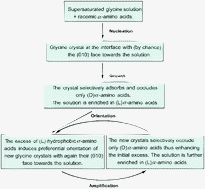We introduce and numerically solve a mathematical model of the experimentally established mechanisms responsible for the symmetry breaking transition observed in the chiral crystallization experiments reported by I. Weissbuch, L. Addadi, L. Leiserowitz and M. Lahav, J. Am. Chem. Soc., 1988, 110, 561–567. The mathematical model is based on five basic processes: (1) the formation of achiral glycine clusters in solution, (2) the nucleation of oriented glycine crystals at the air/water interface in the presence of hydrophobic amino acids, (3) a kinetic orienting effect which inhibits crystal growth, (4) the enantioselective occlusion of the amino acids from solution, and (5) the growth of oriented host glycine crystals at the interface. We translate these processes into differential rate equations. We first study the model with the orienting process (2) without (3) and then combine both allowing us to make detailed comparisons of both orienting effects which actually act in unison in the experiment. Numerical results indicate that the model can yield a high percentage orientation of the mixed crystals at the interface and the consequent resolution of the initially racemic mixture of amino acids in solution. The model thus leads to separation of enantiomeric territories, the generation and amplification of optical activity by enantioselective occlusion of chiral additives through chiral surfaces of glycine crystals.

You have access to this article
 Please wait while we load your content...
Something went wrong. Try again?
Please wait while we load your content...
Something went wrong. Try again?


 Please wait while we load your content...
Please wait while we load your content...